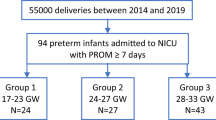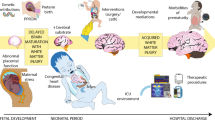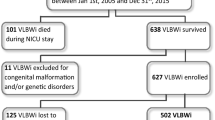Abstract
Objectives:
Investigate cardiorespiratory outcomes in children surviving previable preterm premature rupture of membranes (PV-PPROM) before 22 weeks’ gestational age (GA) with minimum 2 weeks latency.
STUDY Design:
Single institution, follow-up of retrospectively identified children who were born after PV-PPROM during 2000–2004, and individually matched preterm-born controls.
Results:
Eleven PV-PPROM and matched control children were included at mean age of 10.5 and 10.7 years. Rupture of membranes occurred at mean GA 182 and 276 weeks and birth at 283 and 286 weeks, respectively. Compared to controls, the PV-PPROM group had significantly poorer lung function, findings on echocardiography indicating mild pulmonary hypertension, and lower peak oxygen consumption. Chart reviews suggested more motor difficulties and a tendency towards more problems with learning and attention.
Conclusion:
The findings highlight a preterm-born sub-group in need of targeted long-term monitoring and possibly interventions regarding future cardiorespiratory and neurodevelopmental function.
This is a preview of subscription content, access via your institution
Access options
Subscribe to this journal
Receive 12 print issues and online access
$259.00 per year
only $21.58 per issue
Buy this article
- Purchase on Springer Link
- Instant access to full article PDF
Prices may be subject to local taxes which are calculated during checkout


Similar content being viewed by others

References
Waters TP, Mercer BM . The management of preterm premature rupture of the membranes near the limit of fetal viability. Am J Obstet Gynecol 2009; 201: 230–240.
Yeast JD . Preterm premature rupture of the membranes before viability. Clin Perinatol 2001; 28: 849–860.
Linehan LA, Walsh J, Morris A, Kenny L, O'Donoghue K, Dempse E et al. Neonatal and maternal outcomes following midtrimester preterm premature rupture of the membranes: a retrospective cohort study. BMC Pregnancy Childbirth 2016; 16: 25.
Margato MF, Martins GL, Passini Junior R, Nomura ML . Previable preterm rupture of membranes: gestational and neonatal outcomes. Arch Gynecol Obstet 2012; 285: 1529–1534.
Obstetrics NSoGa. Guide in Obstetrics 2014.
Azria E, Anselem O, Schmitz T, Tsatsaris V, Senat MV, Goffinet F . Comparison of perinatal outcome after pre-viable preterm prelabour rupture of membranes in two centres with different rates of termination of pregnancy. BJOG 2012; 119: 449–457.
Gynaecologists RCoOa. Preterm Prelabour Rupture of Membranes, RCOG Green-top Guideline No. 44. 2006.
Worldwide variation in prevalence of symptoms of asthma, allergic rhinoconjunctivitis, and atopic eczema: ISAAC. The International Study of Asthma and Allergies in Childhood (ISAAC) Steering Committee. Lancet 1998; 351: 1225–1232.
Jobe AH, Bancalari E . Bronchopulmonary dysplasia. Am J Respir Crit Care Med 2001; 163: 1723–1729.
Wanger J, Clausen JL, Coates A, Pedersen OF, Brusasco V, Burgos F et al. Standardisation of the measurement of lung volumes. Eur Respir J 2005; 26: 511–522.
Miller MR, Hankinson J, Brusasco V, Burgos F, Casaburi R, Coates A et al. Standardisation of spirometry. Eur Respir J 2005; 26: 319–338.
Quanjer PH, Stanojevic S, Cole TJ, Baur X, Hall GL, Culver BH et al. Multi-ethnic reference values for spirometry for the 3-95-yr age range: the global lung function 2012 equations. Eur Respir J 2012; 40: 1324–1343.
Rosenthal M, Cramer D, Bain SH, Denison D, Bush A, Warner JO . Lung function in white children aged 4 to 19 years: II—Single breath analysis and plethysmography. Thorax 1993; 48: 803–808.
Cumming GR, Everatt D, Hastman L . Bruce treadmill test in children: normal values in a clinic population. Am J Cardiol 1978; 41: 69–75.
Jones NL, Makrides L, Hitchcock C, Chypchar T, McCartney N . Normal standards for an incremental progressive cycle ergometer test. Am Rev Respir Dis 1985; 131: 700–708.
Pettersen MD, Du W, Skeens ME, Humes RA . Regression equations for calculation of z scores of cardiac structures in a large cohort of healthy infants, children, and adolescents: an echocardiographic study. J Am Soc Echocardiogr 2008; 21: 922–934.
National High Blood Pressure Education Program Working Group on High Blood Pressure in C, Adolescents. The fourth report on the diagnosis, evaluation, and treatment of high blood pressure in children and adolescents. Pediatrics 2004; 114: 555–576.
Vollsaeter M, Skromme K, Satrell E, Clemm H, Røksund O, Øymar K et al. Children born preterm at the turn of the millennium had better lung function than children born similarly preterm in the early 1990s. PloS One 2015; 10: e0144243.
Koestenberger M, Ravekes W, Everett AD, Stueger HP, Heinzl B, Gamillscheg A et al. Right ventricular function in infants, children and adolescents: reference values of the tricuspid annular plane systolic excursion (TAPSE) in 640 healthy patients and calculation of z score values. J Am Soc Echocardiogr 2009; 22: 715–719.
Markestad T, Kaaresen PI, Ronnestad A, Reigstad H, Lossius K, Medbø S et al. Early death, morbidity, and need of treatment among extremely premature infants. Pediatrics 2005; 115: 1289–1298.
Williams O, Hutchings G, Debieve F, Debauche C . Contemporary neonatal outcome following rupture of membranes prior to 25 weeks with prolonged oligohydramnios. Early Hum Dev 2009; 85: 273–277.
Everest NJ, Jacobs SE, Davis PG, Begg L, Rogerson S . Outcomes following prolonged preterm premature rupture of the membranes. Arch Dis Child Fetal Neonatal Ed 2008; 93: F207–F211.
Lee JY, Ahn TG, Jun JK . Short-term and long-term postnatal outcomes of expectant management after previable preterm premature rupture of membranes with and without persistent oligohydramnios. Obstet Gynecol 2015; 126: 947–953.
Patkai J, Schmitz T, Anselem O, Mokbat S, Jarreau PH, Goffinet F et al. Neonatal and two-year outcomes after rupture of membranes before 25 weeks of gestation. Eur J Obstet Gynecol Reprod Biol 2013; 166: 145–150.
Manuck TA, Varner MW . Neonatal and early childhood outcomes following early vs later preterm premature rupture of membranes. Am J Obstet Gynecol 2014; 211: 308 e301–306.
Kaplan E, Bar-Yishay E, Prais D, Klinger G, Mei-Zahav M, Mussaffi H et al. Encouraging pulmonary outcome for surviving, neurologically intact, extremely premature infants in the postsurfactant era. Chest 2012; 142: 725–733.
Kitterman JA . Physiological factors in fetal lung growth. Can J Physiol Pharmacol 1988; 66: 1122–1128.
Moessinger AC, Harding R, Adamson TM, Singh M, Kiu GT . Role of lung fluid volume in growth and maturation of the fetal sheep lung. J Clin Invest 1990; 86: 1270–1277.
Angtuaco MJ, Vyas HV, Malik S, Seib PM, Morrow WR, Sachdeva R . Noninvasive estimation of diastolic pulmonary artery pressure by Doppler analysis of tricuspid regurgitation velocity in pediatric patients. Congenit Heart Dis 2012; 7: 131–138.
Hopper RK, Abman SH, Ivy DD . Persistent challenges in pediatric pulmonary hypertension. Chest 2016; 150: 226–236.
Bossone E, Rubenfire M, Bach DS, Ricciardi M, Armstrong WF . Range of tricuspid regurgitation velocity at rest and during exercise in normal adult men: implications for the diagnosis of pulmonary hypertension. J Am Coll Cardiol 1999; 33: 1662–1666.
Zakaria D, Sachdeva R, Gossett JM, Tang X, O'Connor MJ . Tricuspid annular plane systolic excursion is reduced in infants with pulmonary hypertension. Echocardiography 2015; 32: 834–838.
Mourani PM, Abman SH . Pulmonary vascular disease in bronchopulmonary dysplasia: pulmonary hypertension and beyond. Curr Opin Pediatr 2013; 25: 329–337.
Khemani E, McElhinney DB, Rhein L, Andrade O, Lacro RV, Thomas KC et al. Pulmonary artery hypertension in formerly premature infants with bronchopulmonary dysplasia: clinical features and outcomes in the surfactant era. Pediatrics 2007; 120: 1260–1269.
Joshi S, Wilson DG, Kotecha S, Pickerd N, Fraser AG, Kotecha S . Cardiovascular function in children who had chronic lung disease of prematurity. Arch Dis Child Fetal Neonatal Ed 2014; 99: F373–F379.
Clemm H, Roksund O, Thorsen E, Eide GE, Markestad T, Halvorsen T . Aerobic capacity and exercise performance in young people born extremely preterm. Pediatrics 2012; 129: e97–e105.
Baker CD, Alvira CM . Disrupted lung development and bronchopulmonary dysplasia: opportunities for lung repair and regeneration. Curr Opin Pediatr 2014; 26: 306–314.
Baraldi E, Filippone M . Chronic lung disease after premature birth. N Engl J Med 2007; 357: 1946–1955.
Bush A, Busst CM, Knight WB, Hislop AA, Haworth SG, Shinebourne EA . Changes in pulmonary circulation in severe bronchopulmonary dysplasia. Arch Dis Child 1990; 65: 739–745.
Stocks J, Hislop A, Sonnappa S . Early lung development: lifelong effect on respiratory health and disease. Lancet Respir Med 2013; 1: 728–742.
Acknowledgements
We thank the children who participated in this study and their parents. The Western Norway Regional Health Authority and the University of Bergen.
Author information
Authors and Affiliations
Corresponding author
Ethics declarations
Competing interests
The authors declare no conflict of interest.
Additional information
Supplementary Information accompanies the paper on the Journal of Perinatology website
Supplementary information
Rights and permissions
About this article
Cite this article
Bentsen, M., Satrell, E., Reigstad, H. et al. Mid-childhood outcomes after pre-viable preterm premature rupture of membranes. J Perinatol 37, 1053–1059 (2017). https://doi.org/10.1038/jp.2017.97
Received:
Revised:
Accepted:
Published:
Issue Date:
DOI: https://doi.org/10.1038/jp.2017.97


